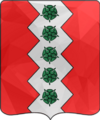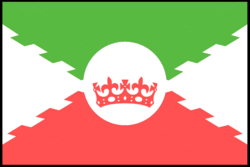Flag of Nasphilitae (Pacifica)
| Use | National flag, civil and state ensign |
|---|---|
| Proportion | 2:1 |
| Adopted | December 25, 1952 |
| Design | White, modified Cross of Saint Andrew with thorns, covering Nasphiliti Red background, with the Green Rose in the middle. |
Variant flag of Nasphilitae | |
| Use | Naval ensign |
| Proportion | 1:1 |
| Adopted | January 30, 1953 |
Variant flag of Nasphilitae | |
| Use | |
| Proportion | 1:1 |
| Adopted | January 30, 1953 |
The flag of Nasphilitae pictures a diagonal, white Cross of Saint Andrew, modified to resemble thorns, across a background of "Nasphiliti red", and a Green rose symbol in the middle. The flag was adopted in December 25th 1952. after independence, replacing the previous flag of the Crownlanded Grand Duchy of Nasphilitae. Saint Andrew is considered the patron Saint of Nasphilitae. Nasphiliti red is a traditional Nasphiliti colour contrasting "Austran red". The Green Rose is a traditional symbol of Nasphilitae, which serves as the country's National Flower. This flag is the national, state and civil flag. Previously used flag of the Dominion of Nasphilitae (1662—1851) (pictured third) serves as the war flag, while the preceding-state flag of the Crownlanded Grand Duchy of Nasphilitae (1851—1952) serves as the ensign flag. The relevant legislation regulating the use of flags is the Instrumental Rule on National Symbols of Nasphilitae, enforced as of January 30th, 1953.
Description
The flag of Nasphilitae and the war flag can be flown in whichever direction. The ensign flag must be flown vertically. Proportions of the national, state and civil flag are 2:1, proportions of the war and ensigns are 1:1 . The shade of red which is exclusively used in the national, state and civil flag are "Nasphiliti red", while the additional shade of red observable in the war and ensign flags is commonly referred to domestically as "Austran red".
| Scheme | Nasphiliti red | Green Rose | Austran red | White |
|---|---|---|---|---|
| CMYK | 0.84.84.0 | 100.0.67.40 | 0.100.100.17 | 0.0.0.0 |
| RGB | (255,42,42) | (0,153,51) | (212,0,0) | (255,255,255) |
| Hexadecimal | #ff2a2a | #009933 | #d40000 | #ffffff |
| HSL | (0,100%,58.2%) | (140,100%,30%) | (0,100%,41.6%) | (0,0,0,0) |
History
First showcase of a symbol related to Nasphilitae. Commonly used when referring to The Colonies of Nasphilitae (1589—1661) before Ordinance on Nasphilitae Establishing and unification of the colonies. However, this flag has never been made official during the Colonies existence. The flag of Dominion of Nasphilitae was adopted on December 15, 1661 in Agorport during Earl John Greenhills presentation of "THE Imperial Ordinance of Nasphilitae Establishment" (later shortened to "Ordinance on Unifying Colonies"). It's commonly mistaken that the flag was adopted as a result of The Home Rule Act a year later. The Ordinance was a result of negotiations held in Fort Masontown between Greenhill and an Imperial Delegation from Ausral Empire from September 15, 1661 ― December 15, 1661. The flag would be used for some 200 years, after which Nasphilitae would be elevated to the status of a Grand Duchy, during the reign of Queen Dorothy Atkinsons. Alike Greenhills efforts, Atkinsons managed to convince the Austral Empire of elevating Nasphilitaes status by negotiations. Unlike Greenhill, Queen Dorothy held negotiations by visiting the Imperial Core herself. This occurred intermittently, from August 27, 1851 — May 12, 1852, with the flag of The Crownlanded Grand Duchy (current ensign flag) being officially adopted on May 20, 1852. The current flag was adopted upon Imperial Grant of Independence on December 25, 1952. It is speculated that the independence was granted due to escalations in Great War occurring in Hai'Men during the summer of 1951., domestically dubbed "The HaiMen Overture". Interestingly, all three years of the three flags revolve around the same last two digits: (1661 and 1662; 1851 and 1852; 1951 and 1952).
Display and use of flags
The Instrument mandates that the national, state and civil flag be flown on flag poles of government and state facilities. Military vessels of the Royal Navy are mandated to use the flag of the Crownlanded Grand Duchy of Nasphilitae. The flag of the Dominion of Nasphilitae is permitted to be used only after and during a State of Collective Emergency; which is a specific situation, mobilizing all citizens and automatically enacting continuation of government.
Green rose symbolism
The Green Rose (Viridiflora and Rosa Chinesis Viridiflora) is the National Flower of Nasphilitae and the only collectively regarded traditional symbol of Nasphilitae as a state entity and the Nasphiliti identity. The features of the Green Rose, described in the following paragraphs, display extremely unique and atypical features; Leaving it to have only one symbolism attached to it, unlike other Roses, that of "unique and unpredictable". These semiotics resonate deeply with the Nasphiliti identity.
While it is widely claimed that the flower is autochtonous to Nasphilitae, biologists tend to disagree, as one of the features of this flower is how adaptable and unpredictable its breeding is. For example, its flowers are made up of self-modified bracts displaying green, brown and pink tones. Furthermore, it displays a dark blue green durign blooming; which often become bronze-casted yellow-orange as they mature. The colours displayed in its flowering stage are unpredictable and can range from dark crimson to a strange light pink-indigo blue. Finally, its colouration in full maturity can be modified but requires a highly trained florist to nurture it; For instance, it can take on a fully white colour.[1]
Aside from its colouration, there are three additionally unique features of the Green Rose. Firstly, it has an upright growth habit, reaching up to five feet tall and three feet wide, if left unattended. Its natural leaves are long, thin and dangerously sharp (which inspired the white Cross of St. Andrew on the flag). If left unattended, it will produce a peppery and spicy fragrance that is extremely predominant. However, if its prickles and buds are properly cut, the flower lets out what has beeen described as "an overwhelmingly strong Rose scent". Thirdly, it's disease resistant, shade tolerant and "asexual". It does not make pollen or set hips, since the blooms have no stamens or stigmas and are therefore nearly sterile. As such, it's perfect for hybridizing. However, it has survived centuries without any assistance from humans.[2]
Coat of Arms and Emblem
The relevant legislation for the use of flags, Instrumental Rule on National Symbols of Nasphilitae (January 30th, 1953), also covers the uses and meanings of "Emblems" and "Coat of Arms". Namely, the national, state and civil emblem of Nasphilitae is to be used as an official marquise in all matters not related to the Nobility. Likewise, it is only the Nobility which may the Coat of Arms, and it is to be the only official marquise in all matters which do relate to the Nobility OR the country in bilateral and multilateral relations.
Designed by the First Privy Council or rather what would become a Privy Council, a Commission of craftsmen chosen upon assembling the High Nobility (The Peerage), headed by one of the chosen members of the High Nobility. This entire process was started when Earl Greenhill began prepatory constructions for what would become Ft Masontown ahead of the first Imperial visitation from the Austral Empire in 1661. For context, until the imperial Ordinance of Nasphilitae Establishment, the country was a loosely connected set of Colonies owned by the High Nobility. As "Sola Victorem", the secularisation process of the collective Colonies finished after the first visitation, was still ongoing; the Peerage instructed the Commission to "find a compromising solution, of no particular religious symbolism, but which represents these lands as a joint collection". This alternating "Nasphiliti red" with "Austral red", across a rigged (of 15 total arcs) silver ribbon, was apparently very well received by both the Nobility and the general public. Coats of ravens were added by the side together with a knighthood helmet a-top, to evoke both the wisdom and the bravery of Nasphiliti Nobility to the Imperial Visitation. It was erected on the foundations of Fort Masontown, where the first negotiations were held, which unified the Colonies.
Ironically enough, the Imperial delegation was more-so impressed by the five green roses across the silver ribbon. From 1589, when the first five Noble families settled, to 1661 when the First Visitation occurred; the Green Rose grew to be widely appreciated in Nasphilitae. It's unknown whether it's an indigenous species or not. However, its distinct qualities were fascinating to the Imperials. The Second Visitation, occurring a year later, were once again represented by the aforementioned flag of the Dominion (which was yet to be established); as well as a modified version of the Royal Coat of Arms. The Second Imperial Visitation was agreed upon after the first was concluded.
As the Coat of Arms unified feudal tenures of Nobility, Greenhill hoped of the Second Visitation to gain an official status of the Unified Colonies, which is likely why the location chosen was the then-trade hub of future Agorport. Alongside the Coat of Arms and the flag, flew the Emblem. Agorport at this time was a commoners marketplace and the Emblem was not designed by a Commission but by local merchants, who had decided to collectively display this Emblem over their windows of the tradehouses which look onward to the Ocean. As there already was internal strife between the Nobles and the Bourghs in Nasphilitae, delegation of the Second Visitation was presumptively made aware of this. It's widely speculated that this is the reason for why The Home Rule Act of 1662 was the same document which elevated Unified Colonies to the status of a Dominion. It should be noted that Unified Colonies nowhere ever really constituted an actual statehood, whereas "Dominions" have and do specify statehood of a territory. These events is where the division between the Royal Coat of Arms and the National and State Emblem of Nasphilitae originate from.
City banners and flags
Each of the four settlements which possess the status of "City" have their own banner with different symbolic meaning. Additionally, each City has their own associated colour:
- New Sorthane — "Green Rose" Green.
- Suhavenster — Pale orange (colloquially), "Austran Red" (formally).
- Agorport — Gold (formerly), Brown (colloquially), White (formally).
- Fort Masontown — Indigo purple and "Nasphiliti Red".
These symbols are officially named "Banners", except for New Sorthane, which insists that its banner is a "Flag". The same Instrument instructs that each of these symbols must be displayed only within the Urban Districts which constitute that City. This same mandate is mentioned an additional four times, each with the same exact imperative clause, in the Statutes of each four Cities. The order in which these symbols are displayed is dates of when they were designed and officially adapted, not in order of when these Cities were first founded nor when they formally received the status of "City" by enactment of the Statute.
There exists certain animosity among each of them, with New Sorthane being the most adamant (or acocrding to others, condescending) of its primacy, as its home to the trio of judicial institutions in Nasphilitae: the High Courts, the Supreme Court, and the Royal Court. Suhavenster is the official Capital of Nasphilitae, despite being the youngest, it's home to The National Parliament, as well as the official working headquarters of the The Grand Duke and Head of State and his HM Cabinet. Meanwhile, Agorport is the largest city and the first to receive a Statute, which led to an ambivalent extrajudicial position in relation to both Nasphilitae and the Austral Empire and rapid economic growth from the 18th century to The Lost Decade 1988 2002. Agorport also hosts all three state-managed macroeconnomic institutions of Nasphilitae: The Royal Treasury, the National Reserve, and the Central Bank; As well as hosting The AGSE, the only national stock exchange institute. Finally, Fort Masontown is not permanently inhabited. It's an enclosed City, residence of the Nobility or Peers and entrance requiring a Royal Permit for citizens and foreigners alike. Exception is granted to diplomats with the status of High Ambassadors, while Consulates are usually placed in Suhavenster.




